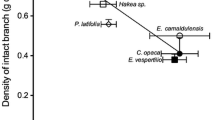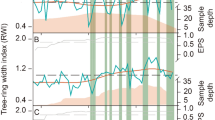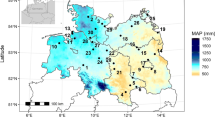Abstract
Key message
For three widespread European Acer species with different climate envelopes, hydraulic traits, but not wood anatomical or leaf morphological traits, were good indicators for habitat preferences.
Abstract
Prediction of drought impacts on trees requires knowledge about species differences in hydraulic traits and how the hydraulic constitution changes along water availability gradients. We studied co-occurring mature trees of three widespread European Acer species with different climate envelopes and habitat preferences for branch hydraulic (embolism resistance, hydraulic conductivity), wood anatomical (vessel diameter, vessel density, wood density) and leaf functional traits (specific leaf area, sapwood-to-leaf area ratio, foliar δ13C), and branch growth rate. Study objectives were to examine the relation between hydraulic traits and the species’ habitat preferences and to confirm several commonly anticipated trade-offs in hydraulic traits at the genus level. The species’ habitat preferences were reflected in the hydraulic traits, but not in the studied wood anatomical or leaf traits. Embolism resistance (P12, P50 and P88 values) decreased and pit conductivity (potential minus measured conductivity) increased in the sequence A. campestre–A. platanoides–A. pseudoplatanus in parallel with the species’ putative drought tolerance. As expected, a trade-off was found between branch hydraulic efficiency and safety. Wood density was related to hydraulic safety, but neither to hydraulic efficiency nor other wood anatomical traits including vessel diameter. Branch growth rate was unrelated to wood density, but linked to vessel diameter and hydraulic conductivity. The findings from the three maple species suggest that hydraulic traits may be under stronger genetic control than leaf and wood anatomical traits that exhibited a more plastic response to the environment. The former are thus better indicators of habitat preferences.







Similar content being viewed by others
References
Alder NN, Sperry JS, Pockman WT (1996) Root and stem xylem embolism, stomatal conductance, and leaf turgor in Acer grandidentatum populations along a soil moisture gradient. Oecologia 105:293–301
Allen CD, Breshears DD, McDowell NG (2015) On underestimation of global vulnerability to tree mortality and forest die-off from hotter drought in the Anthropocene. Ecosphere 6:1–55
Anderegg WRL, Berry JA, Smith DD, Sperry JS, Anderegg LDL, Field CB (2012) The roles of hydraulic and carbon stress in a widespread climate-induced forest die-off. Proc Natl Acad Sci USA 109:233–237
Anderegg WRL, Klein T, Bartlett M, Sack L, Pellegrini AFA, Choat B, Jansen S (2016) Meta-analysis reveals that hydraulic traits explain cross-species patterns of drought-induced tree mortality across the globe. Proc Natl Acad Sci 113:5024–5029
Anderegg WRL, Meinzer FC (2015) Wood anatomy and plant hydraulics in a changing climate. In: Hacke U (ed) Functional and ecological Xylem anatomy. Springer, Cham
Awad H, Barigah T, Badel E, Cochard H, Herbette S (2010) Poplar vulnerability to xylem cavitation acclimates to drier soil conditions. Physiol Plant 139:280–288
Brodribb TJ, Cochard H (2009) Hydraulic failure defines the recovery and point of death in water-stressed conifers. Plant Physiol 149:575–584
Choat B, Brodie TW, Cobb AR, Zwieniecki MA, Holbrook NM (2006) Direct measurements of intervessel pit membrane hydraulic resistance in two angiosperm tree species. Am J Bot 93:993–1000
Choat B, Sack L, Holbrook NM (2007) Diversity of hydraulic traits in nine Cordia species growing in tropical forests with contrasting precipitation. New Phytologist 175:686–698
Choat B, Jansen S, Brodribb TJ, Cochard H, Delzon S, Bhaskar R, Bucci SJ, Feild TS, Gleason SM, Hacke UG et al (2012) Global convergence in the vulnerability of forests to drought. Nature 491:752–755
Carlquist S (1977) Ecological factors in wood evolution—floristic approach. Am J Bot 64:887–896
Cochard H (2002) A technique for measuring xylem hydraulic conductivity under high negative pressures. Plant Plant Cell Environ J 25:815–819
Cochard H, Casella E, Mencuccini M (2007) Xylem vulnerability to cavitation varies among poplar and willow clones and correlates with yield. Tree Physiol 27:1761–1767
Cochard H, Damour G, Bodet C, Tharwat I, Poirier M, Ameglio T (2005) Evaluation of a new centrifuge technique for rapid generation of xylem vulnerability curves. Physiol Plant 124:410–418
Corcuera L, Cochard H, Gil-Pelegrin E, Notivol E (2011) Phenotypic plasticity in mesic populations of Pinus pinaster improves resistance to xylem embolism (P50) under severe drought. Trees 25:1033–1042
Dai A (2013) Increasing drought under global warming in observations and models. Nat Clim Change 3:52–58
Dietrich L, Hoch G, Kahmen A, Körner C (2018) Losing half the conductive area hardly impacts the water status of mature trees. Sci Rep 8:15006
Domec J-C, Gartner BL (2001) Cavitation and water storage capacity in bole xylem segments of mature and young Douglas-fir trees. Trees 15:204–214
Dulamsuren C, Abilova SB, Bektayeva M, Eldarov M, Schuldt B, Leuschner C, Hauck M (2019) Hydraulic architecture and vulnerability to drought-induced embolism in southern boreal tree species of Inner Asia. Tree Physiol 39:463–473
Enquist BJ, West GB, Charnov EL, Brown JH (1999) Allometric scaling of production and life history variation in vascular plants. Nature 401:907–911
Fan Z-X, Zhang S-B, Hao G-Y, Slik JWF, Cao K-F (2012) Hydraulic conductivity traits predict growth rates and adult stature of 40 Asian tropical tree species better than wood density. J Ecol 100:732–741
Fichot R, Barigah TS, Chamaillard S, Thiec DL, Laurans F, Chochard H, Brignolas F (2010) Common trade-offs between xylem resistance to cavitation and other physiological traits do not hold among unrelated Populus deltoids x Populus nigra hybrids. Plant Cell Environ 33:1553–1568
Fischer EM, Schär C (2008) Future changes in daily summer temperature variability: driving processes and role for temperature extremes. Clim Dyn 33:917–935
Gleason SM, Butler DW, Ziemińska K, Waryszak P, Westoby M (2012) Stem xylem conductivity is key to plant water balance across Australian angiosperm species. Funct Ecol 26:343–352
Gleason SM, Westoby M, Jansen S, Choat B, Hacke UG, Pratt RB, Bhaskar R, Brodribb TJ, Bucci SJ, Cao K-F et al (2016) Weak tradeoff between xylem safety and xylem-specific hydraulic efficiency across the world’s woody plant species. New Phytol 209:123–136
Guet J, Fichot R, Lédée C, Laurans F, Cochard H, Delzon S, Bastien C, Brignolas F (2015) Stem xylem resistance to cavitation is related to xylem structure but not to growth and water-use efficiency at the within-population level in Populus nigra L. J Experim Bot 66:4643–4652
Hacke UG, Sperry JS, Pittermann J (2004) Anaylsis of circular bordered pit function II. Gymnosperm tracheids with torus-margo pit membranes. Am J Bot 91:386–400
Hacke UG, Sperry JS, Wheeler JK, Castro L (2006) Scaling of angiosperm xylem structure with safety and efficiency. Tree Physiol 26:689–701
Hacke UG, Spicer R, Schreiber SG, Plavcová L (2017) An ecophysiological and developmental perspective on variation in vessel diameter. Plant Cell Environ 40:831–845
Hajek P, Leuschner C, Hertel D, Delzon S, Schuldt B (2014) Trade-offs between xylem hydraulic properties, wood anatomy and yield in Populus. Tree Physiol 34:744–756
Hajek P, Kurjak D, von Wühlisch G, Delzon S, Schuldt B (2016) Intraspecific variation in wood anatomical, hydraulic and foliar traits in ten European beech provenances differing in growth yield. Front Plant Sci 7:791
Hargrave KR, Kolb KJ, Ewers FW, Davis SD (1994) Conduit diameter and drought-induced embolism in Salvia-Mellifera Greene (Labiatae). New Phytol 126:695–705
Hartmann H, Ziegler W, Kolle O, Trumbore S (2013) Thirst beats hunger - declining hydration during drought prevents carbon starvation in Norway spruce saplings. New Phytol 200:340–349
Herbette S, Wortemann R, Awad H, Huc R, Cochard H, Barigah TS (2010) Insights into xylem vulnerability to cavitation in Fagus sylvatica L.: phenotypic and environmental sources of variability. Tree Physiol 30:1448–1455
Hietz P, Valencia R, Wright SJ (2013) Strong radial variation in wood density follows a uniform pattern in two neotropical rain forests. Funct Ecol 27:684–692
Hoeber S, Leuschner C, Köhler L, Arias-Aguilar D, Schuldt B (2014) The importance of hydraulic conductivity and wood density to growth performance in eight tree species from a tropical semi-dry climate, Forest. Ecol Manag 330:126–136
IPCC (2013) Climate change 2013: the physical science basis. Contribution of working group I to the fifth assessment report of the intergovernmental panel on climate change. Cambridge University Press, Campridge
Jacobsen AL, Pratt RB, Ewers FW, Davis SD (2007) Cavitation resistance among 26 chaparral species of southern California. Ecol Monogr 77:99–115
King DA, Davies SJ, Tan S, Noor NSM (2006) The role of wood density and stem support costs in the growth and mortality of tropical trees. J Ecol 94:670–680
Kotowska MM, Hertel D, Abou Rajab Y, Barus H, Schuldt B (2015) Patterns in hydraulic architecture from roots to branches in six tropical tree species from cacao agroforestry and their relation to wood density and stem growth. Front Plant Sci 6:1–16
Larter M, Pfautsch S, Domec J-C, Trueba S, Nagalingum N, Delzon S (2017) Aridity drove the evolution of extreme embolism the radiation of conifer genus Callitris. New Phytol 215:97–112
Lens F, Sperry JS, Christman MA, Choat B, Rabaey D, Jansen S (2011) Testing hypotheses that link wood anatomy to cavitation resistance and hydraulic conductivity in the genus Acer. New Phytol 190:709–723
Leuschner C, Ellenberg H (2017) Ecology of central European forests—vegetation ecology of central Europe, vol I. Springer, Cham
Li S, Lens F, Espino S, Karimi MK, Schenk HJ, Schmitt M, Schuldt B, Jansen S (2016) Intervessel pit membrane thickness as a key determinant of embolism resistance in angiosperm xylem. IAWA J 37:152–171
Maherali H, DeLucia EH (2000) Xylem conductivity and vulnerability to cavitation of ponderosa pine growing in contrasting climates. Tree Physiol 20:859–867
Maherali H, Williams BL, Paige KN, DeLucia EH (2002) Hydraulic differentiation of Ponderosa pine populations along a climate gradient is not associated with ecotypic divergence. Funct Ecol 16:510–521
Maherali H, Pockman WT, Jackson RB (2004) Adaptive variation in the vulnerability of woody plants to xylem cavitation. Ecology 85:2184–2199
Maherali H, Moura CF, Caldeira MC, Willson CJ, Jackson RB (2006) Functional coordination between leaf gas exchange and vulnerability to xylem cavitation in temperate forest trees. Plant Cell Environ J 29:571–583
Markesteijn L, Poorter L, Paz H, Sack L, Bongers F (2011) Ecological differentiation in xylem cavitation resistance is associated with stem and leaf structural traits. Plant Cell Environ 34:137–148
Martínez-Cabrera HI, Schenk HJ, Cevallos-Ferriz SRS, Jones CS (2011) Integration of vessel traits, wood density, and height in angiosperm shrubs and trees. Am J Bot 98:915–922
Martínez-Vilalta J, Cochard H, Mencuccini M, Sterck F, Herrero A, Korhonen JFJ, Llorenz P, Nikinmaa E, Nolè A, Poyatos R, Ripullone F, Sass-Klaassen U, Zweifel R (2009) Hydraulic adjustment of Scots pine across Europe. New Phytol 184:353–364
McDowell N, Pockman WT, Allen CD, Breshears DD, Cobb N, Kolb T, Plaut J, Sperry J, West A, Williams DG et al (2008) Mechanisms of plant survival and mortality during drought: why do some plants survive while others succumb to drought? New Phytol 178:719–739
Neumann M, Mues V, Moreno A, Hasenauer H, Seidl R (2017) Climate variability drives recent tree mortality in Europe. Global Change Biol 23:4788–4797
Ogasa M, Miki NH, Murakami Y, Yoshikawa K (2013) Recovery performance in xylem hydraulic conductivity is correlated with cavitation resistance for temperate deciduous tree species. Tree Physiol 33:335–344
Pammenter NW, Vander Willigen C (1998) A mathematical and statistical analysis of the curves illustrating vulnerability of xylem to cavitation. Tree Physiol 18:589–593
Poorter L, Mcdonald I, Alarcon A, Fichtler E, Licona J-C, Pena-Claros M et al (2010) The importance of wood traits and hydraulic conductivity for the performance and life history strategies of 42 rainforest tree species. New Phytol 185:481–492
Poyatos R, Martínez-Vilalta J, Čermák J, Ceulemans R, Granier A, Irvine J, Köstner B, Lagergren F, Meiresonne L, Nadezhdina N, Zimmermann R, Llorens P, Mencuccini M (2007) Plasticity in hydraulic architecture of Scots pine across Europe. Oecologia 153:245–259
Rowland L, da Costa ACL, Galbraith DR, Oliveira RS, Binks OJ, Oliveira AAR, Pullen AM, Doughty CE, Metcalfe DB, Vasconcelos SS et al (2015) Death from drought in tropical forests is triggered by hydraulics not carbon starvation. Nature 528:119–122
Salmon Y, Torres-Ruiz JM, Poyatos R, Martinez-Vilalta J, Meir P, Cochard H, Mencuccini M (2015) Balancing the risks of hydraulic failure and carbon starvation: a twig scale analysis in declining Scots pine. Plant Cell Environ 38:2575–2588
San-Miguel-Ayanz J, de Rigo D, Caudullo G, Houston Durrant T, Mauri A, Tinner W, Ballian D, Beck P, Birks HJB, Eaton E et al (2016) European atlas of forest tree species. Publications Office of the European Union, Luxembourg
Schreiber SG, Hacke UG, Chamberland S, Lowe CW, Kamelchuk D, Bräutigam K, Campbell MM, Thomas BR (2016) Leaf size serves as a proxy for xylem vulnerability to cavitation in plantation trees. Plant Cell Environ 39:272–281
Schuldt B, Knutzen F, Delzon S, Jansen S, Müller-Haubold H, Burlett R, Clough Y, Leuschner C (2016) How adaptable is the hydraulic system of european beeach in the face of climate change-related precipitation reduction. New Phytol 210:443–548
Skelton RP, West AG, Dawson TE (2015) Predicting plant vulnerability to drought in biodiverse regions using functional traits. Proc Natl Acad Sci 112:5744–5749
Sperry JS, Nichols KL, Sullivan JEM, Eastlack SE (1994) Xylem embolism in ring-porous, diffuse-porous, and coniferous trees of Northern Utah and Interior Alaska. Ecology 75:1736–1752
Sterck FJ, Martínez-Vilalta J, Mencuccini M, Cochard H, Gerrits P, Zweifel R, Herrero A, Korhonen JFJ, Llorens P, Nikinmaa E, Nolè A, Poyatos R, Ripullone F, Sass-Klaassen U (2012) Understanding trait interactions and their impacts on growth in Scots pine branches across Europe. Funct Ecol 26:541–549
Tissier J, Lambs L, Peltier J-P, Marigo G (2004) Relationship between hydraulic traits and habitat preference for six Acer species occurring in the French Alps. Ann For Sci 61:81–86
Togashi HF, Prentice IC, Evans BJ, Forrester DI, Drake P, Feikema P, Brooksbank K, Eamus D, Tylor D (2015) Morphological and moisture availability controls of the leaf area-to-sapwood area ratio: analysis of measurements on Australian trees. Ecol Evolut 5:1263–1270
Torres-Ruiz JM, Cochard H, Fonseca E, Badel E, Gazarini L, Vaz M (2017) Differences in functional and xylem anatomical features allow Cistus species to co-occur and cope differently with drought in the Mediterranean region. Tree Physiol 37:755–766
Trifilò P, Casolo V, Raimondo F, Petrussa E, Boscutti F, Lo Gullo MA, Nardini A (2017) Effects of prolonged drought on stem non-structural carbohydrates content and post-drought hydraulic recovery in Laurus nobilis L.: The possible link between carbon starvation and hydraulic failure. Plant Physiol Biochem 120:232–241
Tyree MT, Sperry JS (1989) Vulnerability of xylem to cavitation and embolism. Ann Rev Plant Biol 40:19–38
Urli M, Porté AJ, Cochard H, Guengant Y, Burlett R, Delzon S (2013) Xylem embolism threshold for catastrophic hydraulic failure in angiosperm trees. Tree Physiol 33:672–683
White FM (1991) Viscous fluid flow, 2nd edn. McGraw-Hill, New York
Willson CJ, Jackson RB (2006) Xylem cavitation caused by drought and freezing stress in four co-occurring Juniperus species. Physiol Plant 127:374–382
Willson CJ, Manos PS, Jackson RB (2008) Hydraulic traits are influenced by phylogenetic history in the drought-resistant, invasive genus Juniperus (Cupressaceae). Am J Bot 95:299–314
Wright IJ, Reich PB, Westoby M, Ackerly DD, Baruch Z, Bongers F, Cavender-Bares J, Chapin T, Cornelissen JHC, Diemer M et al (2004) The worldwide leaf economics spectrum. Nature 428:821–827
Yoshimura K, Saiki S-T, Yazaki K, Ogasa MY, Shirai M, Nakano T, Yoshimura J, Ishida A (2016) The dynamics of carbon stored in xylem sapwood to drought-induced hydraulic stress in mature trees. Sci Rep 6:24513
Ziemińska K, Butler DW, Gleason SM, Wright IJ, Westoby M (2013) Fibre wall and lumen fractions drive wood density variation across 24 Australian angiosperms. AoB Plants 5:plt046
Zimmermann MH (1983) Xylem structure and the ascent of sap. Springer, Berlin
Acknowledgements
We would like to thank Ana Sapoznikova for preparing all transverse sections for wood anatomical analyses, and Jürgen Köhler for branch sample collection. The constructive comments by two anonymous reviewers helped to improve the manuscript.
Author information
Authors and Affiliations
Corresponding author
Ethics declarations
Conflict of interest
The authors declare that they have no conflict of interest.
Additional information
Communicated by Gärtner.
Publisher's Note
Springer Nature remains neutral with regard to jurisdictional claims in published maps and institutional affiliations.
Electronic supplementary material
Below is the link to the electronic supplementary material.
Rights and permissions
About this article
Cite this article
Schumann, K., Leuschner, C. & Schuldt, B. Xylem hydraulic safety and efficiency in relation to leaf and wood traits in three temperate Acer species differing in habitat preferences. Trees 33, 1475–1490 (2019). https://doi.org/10.1007/s00468-019-01874-x
Received:
Revised:
Accepted:
Published:
Issue Date:
DOI: https://doi.org/10.1007/s00468-019-01874-x




